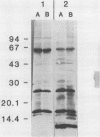Abstract
Haemophilus ducreyi is the causative agent of chancroid, one of the genital ulcerative diseases. H. ducreyi is the major cause of genital ulcer disease in Africa and Southeast Asia and is of increasing concern in the United States. Definitive diagnosis of chancroid requires the isolation and identification of H. ducreyi, but isolation of this organism is difficult and the available medium is not optimal for all strains. Fluorescent antibody and serologic tests are of limited value. In general, our knowledge of this organism is rather limited, and indeed, recent studies have questioned the placement of H. ducreyi in the genus Haemophilus. H. ducreyi has relatively few biochemical activities, and epidemiologic studies are limited because there are limited phenotypic markers available for strain typing. Specific virulence factors of H. ducreyi have yet to be identified. Antimicrobial resistance in H. ducreyi is of special concern, as this organism has acquired both gram-negative and gram-positive resistance determinants. In addition, some of these determinants can be mobilized and transferred to other Haemophilus species or to Neisseria gonorrhoeae.
Full text
PDF
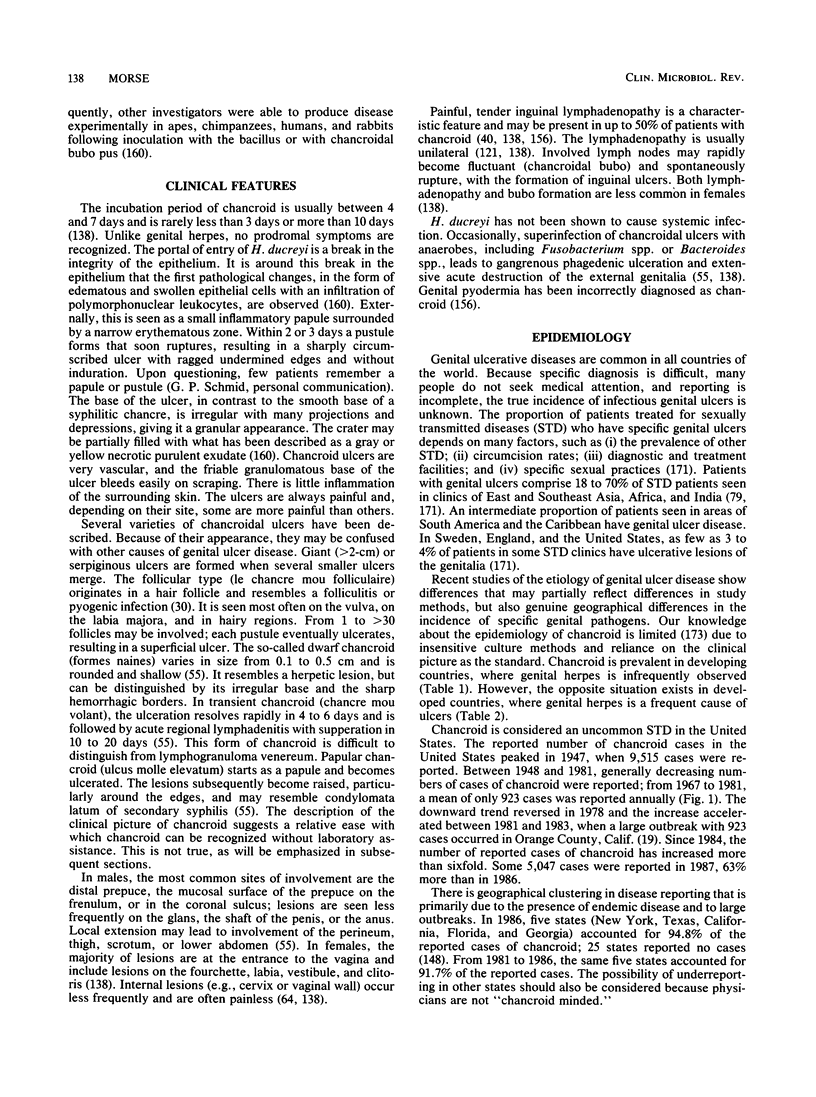


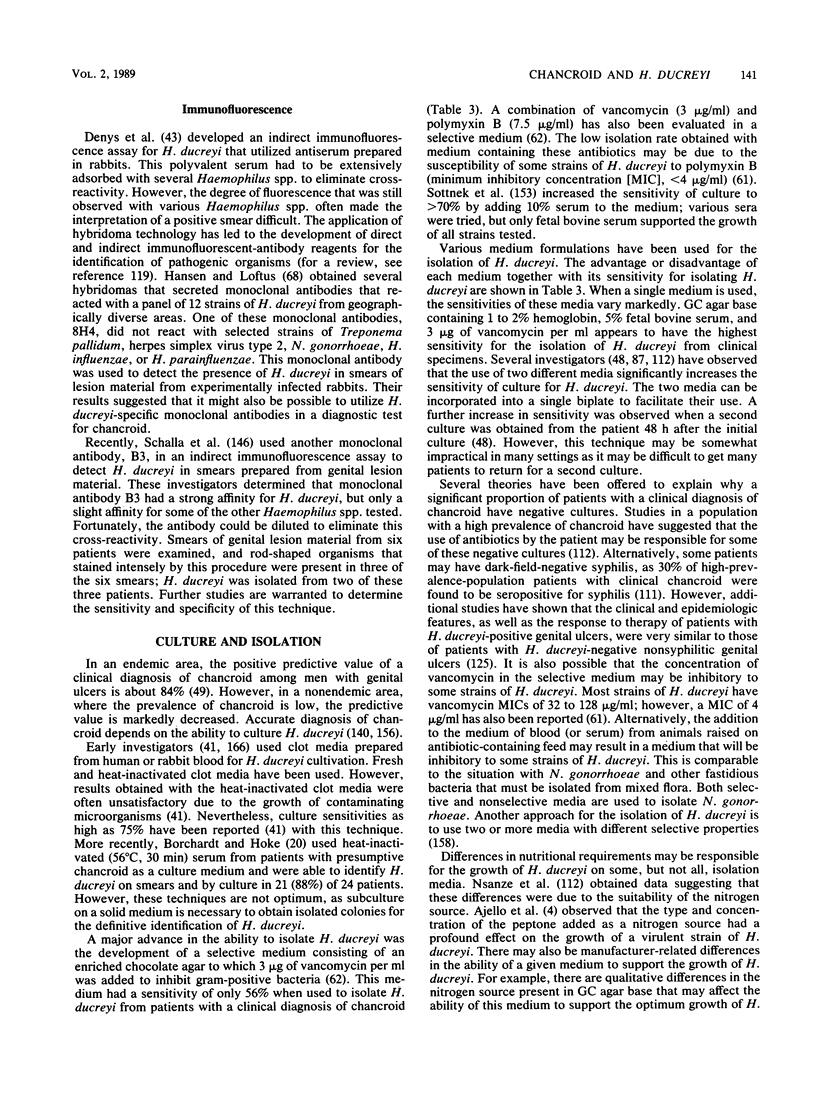
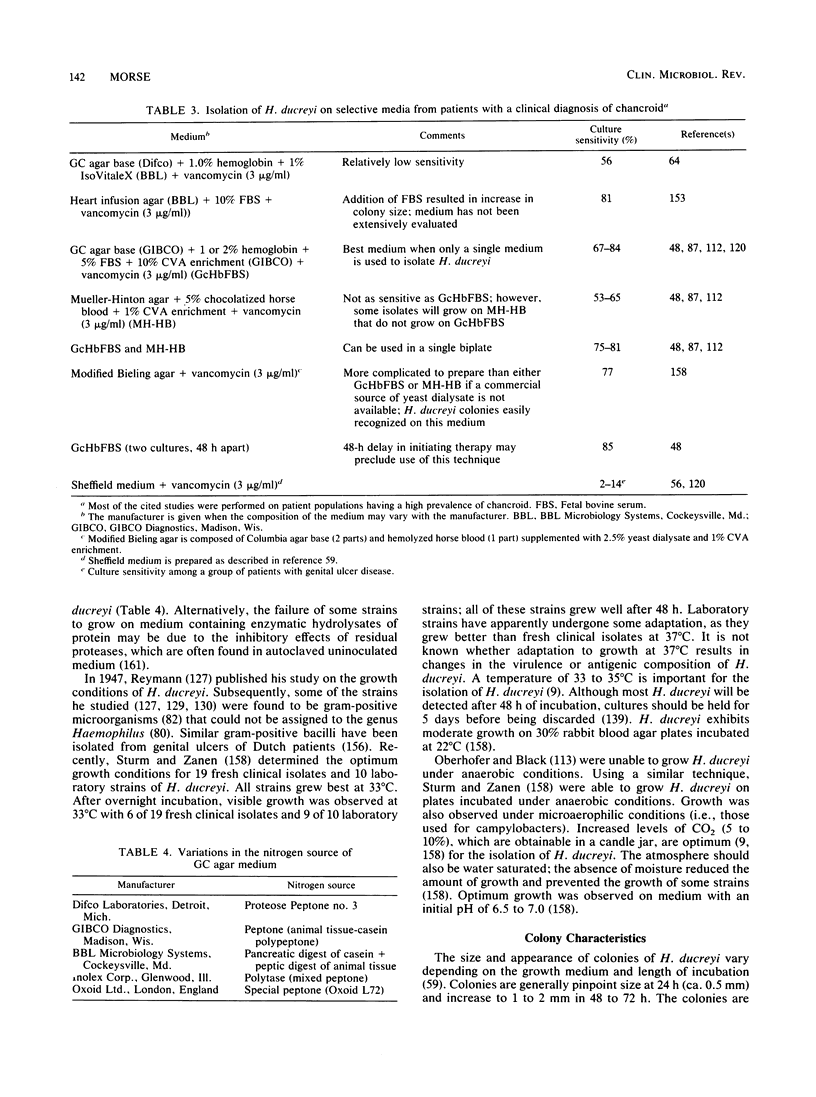





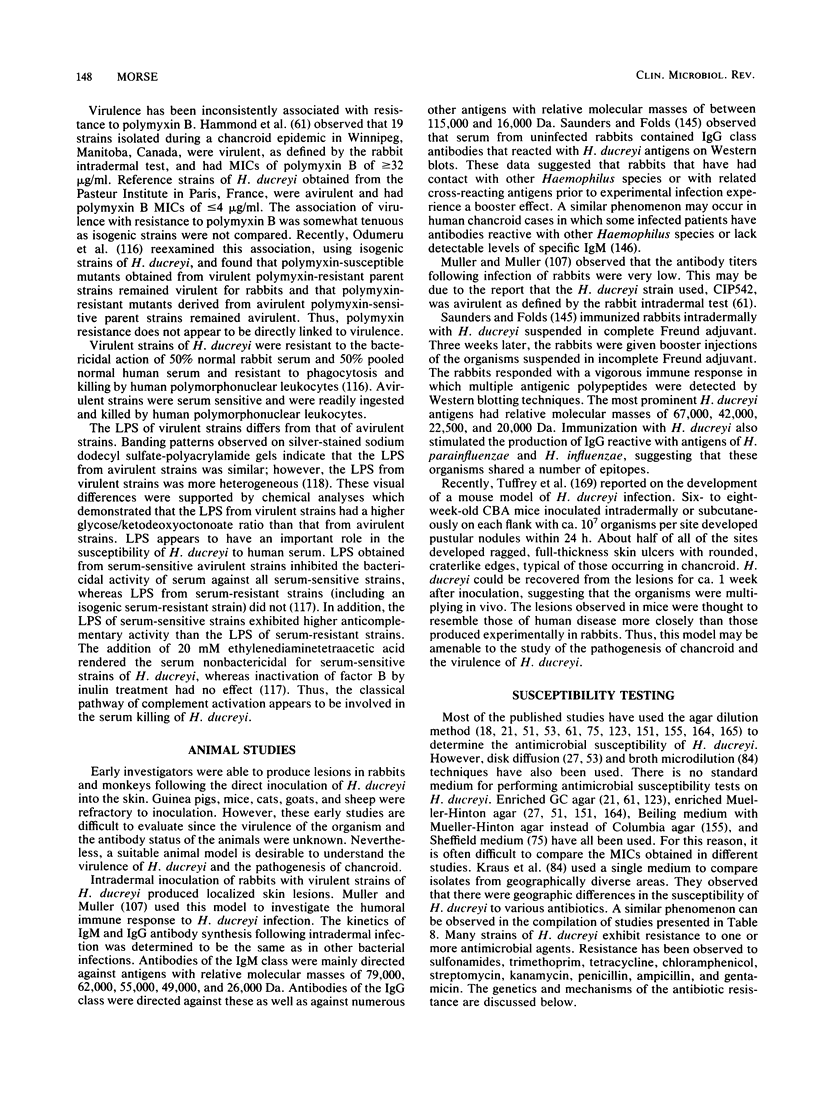





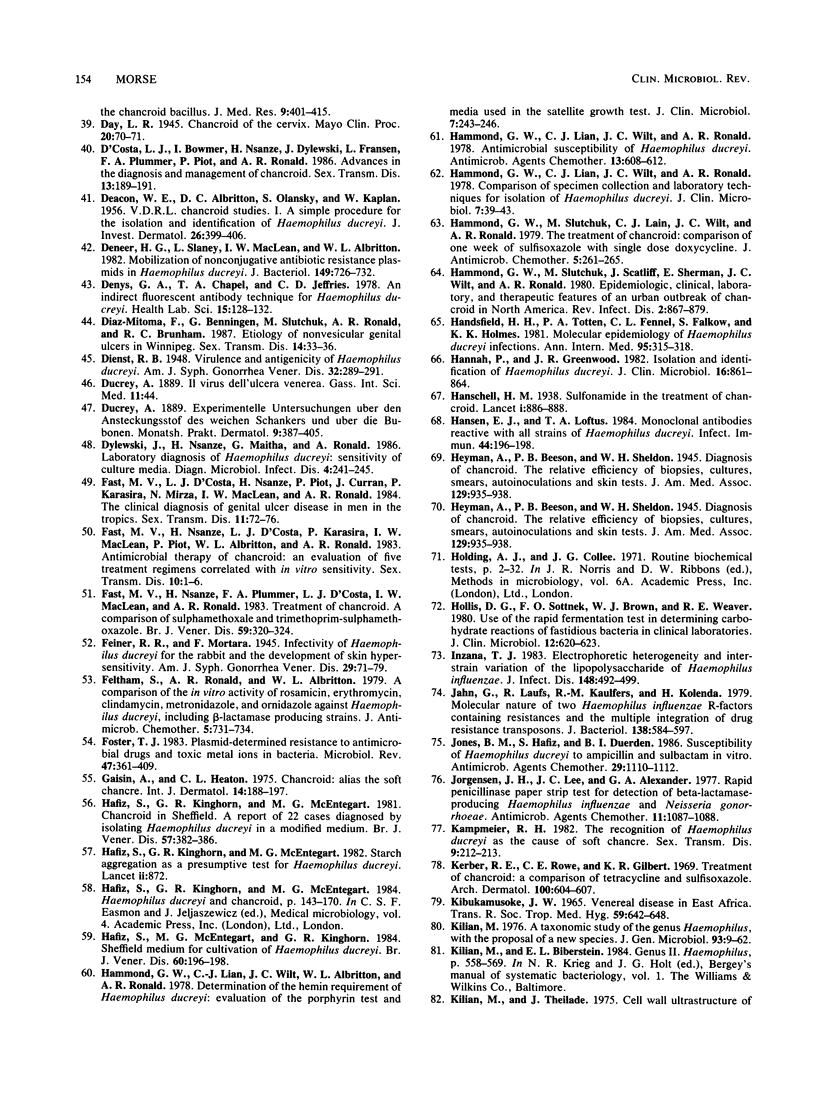
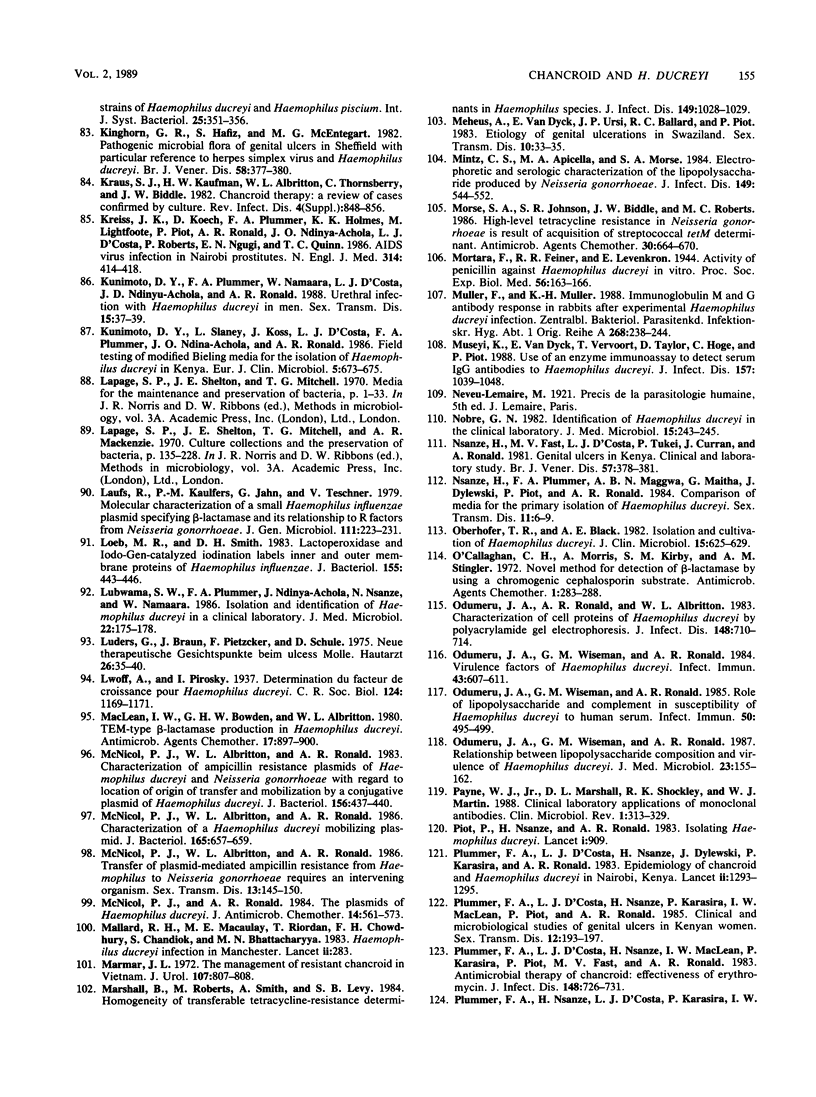
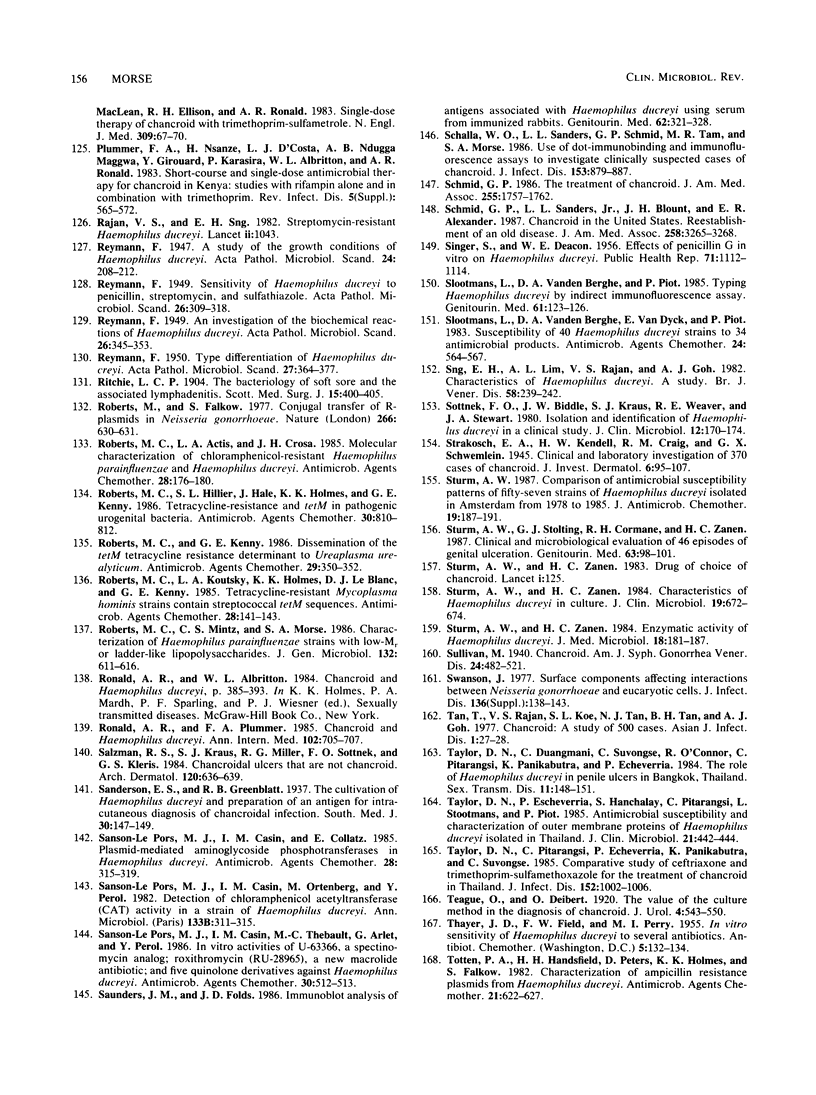

Images in this article
Selected References
These references are in PubMed. This may not be the complete list of references from this article.
- AJELLO G. W., DEACON W. E., PAUL L., WALLS K. W. Nutritional studies of a virulent strain of Haemophilus ducreyi. J Bacteriol. 1956 Dec;72(6):802–808. doi: 10.1128/jb.72.6.802-808.1956. [DOI] [PMC free article] [PubMed] [Google Scholar]
- ASIN J. Chancroid; a report of 1,402 cases. Am J Syph Gonorrhea Vener Dis. 1952 Sep;36(5):483–487. [PubMed] [Google Scholar]
- Albritton W. L., Brunton J. L., Meier M., Bowman M. N., Slaney L. A. Haemophilus influenzae: comparison of respiratory tract isolates with genitourinary tract isolates. J Clin Microbiol. 1982 Nov;16(5):826–831. doi: 10.1128/jcm.16.5.826-831.1982. [DOI] [PMC free article] [PubMed] [Google Scholar]
- Albritton W. L., Brunton J. L., Slaney L., MacLean I. Plasmid-mediated sulfonamide resistance in Haemophilus ducreyi. Antimicrob Agents Chemother. 1982 Jan;21(1):159–165. doi: 10.1128/aac.21.1.159. [DOI] [PMC free article] [PubMed] [Google Scholar]
- Albritton W. L., Maclean I. W., Slaney L. A., Ronald A. R., Deneer H. G. Plasmid-mediated tetracycline resistance in Haemophilus ducreyi. Antimicrob Agents Chemother. 1984 Feb;25(2):187–190. doi: 10.1128/aac.25.2.187. [DOI] [PMC free article] [PubMed] [Google Scholar]
- Anderson B., Albritton W. L., Biddle J., Johnson S. R. Common beta-lactamase-specifying plasmid in Haemophilus ducreyi and Neisseria gonorrhoeae. Antimicrob Agents Chemother. 1984 Feb;25(2):296–297. doi: 10.1128/aac.25.2.296. [DOI] [PMC free article] [PubMed] [Google Scholar]
- Bilgeri Y. R., Ballard R. C., Duncan M. O., Mauff A. C., Koornhof H. J. Antimicrobial susceptibility of 103 strains of Haemophilus ducreyi isolated in Johannesburg. Antimicrob Agents Chemother. 1982 Oct;22(4):686–688. doi: 10.1128/aac.22.4.686. [DOI] [PMC free article] [PubMed] [Google Scholar]
- Blackmore C. A., Limpakarnjanarat K., Rigau-Pérez J. G., Albritton W. L., Greenwood J. R. An outbreak of chancroid in Orange County, California: descriptive epidemiology and disease-control measures. J Infect Dis. 1985 May;151(5):840–844. doi: 10.1093/infdis/151.5.840. [DOI] [PubMed] [Google Scholar]
- Borchardt K. A., Hoke A. W. Simplified laboratory technique for diagnosis of chancroid. Arch Dermatol. 1970 Aug;102(2):188–192. [PubMed] [Google Scholar]
- Bowmer M. I., Nsanze H., D'Costa L. J., Dylewski J., Fransen L., Piot P., Ronald A. R. Single-dose ceftriaxone for chancroid. Antimicrob Agents Chemother. 1987 Jan;31(1):67–69. doi: 10.1128/aac.31.1.67. [DOI] [PMC free article] [PubMed] [Google Scholar]
- Brunton J. L., Maclean I., Ronald A. R., Albritton W. L. Plasmid-mediated ampicillin resistance in Haemophilus ducreyi. Antimicrob Agents Chemother. 1979 Feb;15(2):294–299. doi: 10.1128/aac.15.2.294. [DOI] [PMC free article] [PubMed] [Google Scholar]
- Brunton J., Bennett P., Grinsted J. Molecular nature of a plasmid specifying beta-lactamase production in Haemophilus ducreyi. J Bacteriol. 1981 Dec;148(3):788–795. doi: 10.1128/jb.148.3.788-795.1981. [DOI] [PMC free article] [PubMed] [Google Scholar]
- Brunton J., Meier M., Ehrman N., Maclean I., Slaney L., Albritton W. L. Molecular epidemiology of beta-lactamase-specifying plasmids of Haemophilus ducreyi. Antimicrob Agents Chemother. 1982 Jun;21(6):857–863. doi: 10.1128/aac.21.6.857. [DOI] [PMC free article] [PubMed] [Google Scholar]
- Brunton J., Meier M., Erhman N., Clare D., Almawy R. Origin of small beta-lactamase-specifying plasmids in Haemophilus species and Neisseria gonorrhoeae. J Bacteriol. 1986 Oct;168(1):374–379. doi: 10.1128/jb.168.1.374-379.1986. [DOI] [PMC free article] [PubMed] [Google Scholar]
- CLARKE P. H., COWAN S. T. Biochemical methods for bacteriology. J Gen Microbiol. 1952 Feb;6(1-2):187–197. doi: 10.1099/00221287-6-1-2-187. [DOI] [PubMed] [Google Scholar]
- Carpenter J. L., Back A., Gehle D., Oberhoffer T. Treatment of chancroid with erythromycin. Sex Transm Dis. 1981 Jul-Sep;8(3):192–197. doi: 10.1097/00007435-198107000-00004. [DOI] [PubMed] [Google Scholar]
- Casin I. M., Sanson-Le Pors M. J., Gorce M. F., Ortenberg M., Pérol Y. The enzymatic profile of Haemophilus ducreyi. Ann Microbiol (Paris) 1982 Nov-Dec;133(3):379–388. [PubMed] [Google Scholar]
- Chapel T. A., Brown W. J., Jeffres C., Stewart J. A. How reliable is the morphological diagnosis of penile ulcerations? Sex Transm Dis. 1977 Oct-Dec;4(4):150–152. doi: 10.1097/00007435-197710000-00008. [DOI] [PubMed] [Google Scholar]
- Chapel T., Brown W. J., Jeffries C., Stewart J. A. The microbiological flora of penile ulcerations. J Infect Dis. 1978 Jan;137(1):50–56. doi: 10.1093/infdis/137.1.50. [DOI] [PubMed] [Google Scholar]
- Chen S. T., Clowes R. C. Nucleotide sequence comparisons of plasmids pHD131, pJB1, pFA3, and pFA7 and beta-lactamase expression in Escherichia coli, Haemophilus influenzae, and Neisseria gonorrhoeae. J Bacteriol. 1987 Jul;169(7):3124–3130. doi: 10.1128/jb.169.7.3124-3130.1987. [DOI] [PMC free article] [PubMed] [Google Scholar]
- Chopra I., Howe T. G. Bacterial resistance to the tetracyclines. Microbiol Rev. 1978 Dec;42(4):707–724. doi: 10.1128/mr.42.4.707-724.1978. [DOI] [PMC free article] [PubMed] [Google Scholar]
- Choudhary B. P., Kumari S., Bhatia R., Agarwal D. S. Bacteriological study of chancroid. Indian J Med Res. 1982 Sep;76:379–385. [PubMed] [Google Scholar]
- Coovadia Y. M., Kharsany A., Hoosen A. The microbial aetiology of genital ulcers in black men in Durban, South Africa. Genitourin Med. 1985 Aug;61(4):266–269. doi: 10.1136/sti.61.4.266. [DOI] [PMC free article] [PubMed] [Google Scholar]
- Crewe-Brown H. H., Krige F. K., Davel G. H., Barron C., Van Vuuren J. A., Shipham S. O., Roux J. G. Genital ulceration in males at Ga-Rankuwa Hospital, Pretoria. S Afr Med J. 1982 Nov 27;62(23):861–863. [PubMed] [Google Scholar]
- D'Costa L. J., Bowmer I., Nsanze H., Dylewski J., Fransen L., Plummer F. A., Piot P., Ronald A. R. Advances in the diagnosis and management of chancroid. Sex Transm Dis. 1986 Jul-Sep;13(3 Suppl):189–191. doi: 10.1097/00007435-198607000-00019. [DOI] [PubMed] [Google Scholar]
- DEACON W. E., ALBRITTON D. C., OLANSKY S., KAPLAN W. V.D.R.L. chancroid studies. I. A simple procedure for the isolation and identification of Hemophilus ducreyi. J Invest Dermatol. 1956 May;26(5):399–406. doi: 10.1038/jid.1956.51. [DOI] [PubMed] [Google Scholar]
- DEACON W. E., SINGER S. Effects of penicillin G in vitro on Hemophilus ducreyi. Public Health Rep. 1956 Nov;71(11):1112–1114. [PMC free article] [PubMed] [Google Scholar]
- Deneer H. G., Slaney L., Maclean I. W., Albritton W. L. Mobilization of nonconjugative antibiotic resistance plasmids in Haemophilus ducreyi. J Bacteriol. 1982 Feb;149(2):726–732. doi: 10.1128/jb.149.2.726-732.1982. [DOI] [PMC free article] [PubMed] [Google Scholar]
- Denys G. A., Chapel T. A., Jeffries C. D. An indirect fluorescent antibody technique for Haemophilus ducreyi. Health Lab Sci. 1978 Jul;15(3):128–132. [PubMed] [Google Scholar]
- Diaz-Mitoma F., Benningen G., Slutchuk M., Ronald A. R., Brunham R. C. Etiology of nonvesicular genital ulcers in Winnipeg. Sex Transm Dis. 1987 Jan-Mar;14(1):33–36. doi: 10.1097/00007435-198701000-00007. [DOI] [PubMed] [Google Scholar]
- Dylewski J., Nsanze H., Maitha G., Ronald A. Laboratory diagnosis of Haemophilus ducreyi: sensitivity of culture media. Diagn Microbiol Infect Dis. 1986 Mar;4(3):241–245. doi: 10.1016/0732-8893(86)90103-3. [DOI] [PubMed] [Google Scholar]
- Fast M. V., D'Costa L. J., Nsanze H., Piot P., Curran J., Karasira P., Mirza N., Maclean I. W., Ronald A. R. The clinical diagnosis of genital ulcer disease in men in the tropics. Sex Transm Dis. 1984 Apr-Jun;11(2):72–76. doi: 10.1097/00007435-198404000-00004. [DOI] [PubMed] [Google Scholar]
- Fast M. V., Nsanze H., D'Costa L. J., Karasira P., Maclean I. W., Piot P., Albritton W. L., Ronald A. R. Antimicrobial therapy of chancroid: an evaluation of five treatment regimens correlated with in vitro sensitivity. Sex Transm Dis. 1983 Jan-Mar;10(1):1–6. [PubMed] [Google Scholar]
- Fast M. V., Nsanze H., Plummer F. A., D'Costa L. J., MacLean I. W., Ronald A. R. Treatment of chancroid. A comparison of sulphamethoxazole and trimethoprim-sulphamethoxazole. Br J Vener Dis. 1983 Oct;59(5):320–324. doi: 10.1136/sti.59.5.320. [DOI] [PMC free article] [PubMed] [Google Scholar]
- Feltham S., Ronald A. R., Albritton W. L. A comparison of the in vitro activity of rosamicin, erythromycin, clindamycin, metroidazole and ornidazole against Haemophilus ducreyi, including beta-lactamase producing strains. J Antimicrob Chemother. 1979 Nov;5(6):731–734. doi: 10.1093/jac/5.6.731. [DOI] [PubMed] [Google Scholar]
- Foster T. J. Plasmid-determined resistance to antimicrobial drugs and toxic metal ions in bacteria. Microbiol Rev. 1983 Sep;47(3):361–409. doi: 10.1128/mr.47.3.361-409.1983. [DOI] [PMC free article] [PubMed] [Google Scholar]
- Gaisin A., Heaton C. L. Chancroid: alias the soft chancre. Int J Dermatol. 1975 Apr;14(3):188–197. doi: 10.1111/ijd.1975.14.3.188. [DOI] [PubMed] [Google Scholar]
- Hafiz S., Kinghorn G. R., McEntegart M. G. Chancroid in Sheffield. A report of 22 cases diagnosed by isolating Haemophilus ducreyi in a modified medium. Br J Vener Dis. 1981 Dec;57(6):382–386. doi: 10.1136/sti.57.6.382. [DOI] [PMC free article] [PubMed] [Google Scholar]
- Hafiz S., Kinghorn G. R., McEntegart M. G. Starch aggregation as a presumptive test for Haemophilus ducreyi. Lancet. 1982 Oct 16;2(8303):872–872. doi: 10.1016/s0140-6736(82)90830-3. [DOI] [PubMed] [Google Scholar]
- Hafiz S., McEntegart M. G., Kinghorn G. R. Sheffield medium for cultivation of Haemophilus ducreyi. Br J Vener Dis. 1984 Jun;60(3):196–198. doi: 10.1136/sti.60.3.196. [DOI] [PMC free article] [PubMed] [Google Scholar]
- Hammond G. W., Lian C. J., Wilt J. C., Albritton W. L., Ronald A. R. Determination of the hemin requirement of Haemophilus ducreyi: evaluation of the porphyrin test and media used in the satellite growth test. J Clin Microbiol. 1978 Mar;7(3):243–246. doi: 10.1128/jcm.7.3.243-246.1978. [DOI] [PMC free article] [PubMed] [Google Scholar]
- Hammond G. W., Lian C. J., Wilt J. C., Ronald A. R. Antimicrobial susceptibility of Haemophilus ducreyi. Antimicrob Agents Chemother. 1978 Apr;13(4):608–612. doi: 10.1128/aac.13.4.608. [DOI] [PMC free article] [PubMed] [Google Scholar]
- Hammond G. W., Lian C. J., Wilt J. C., Ronald A. R. Comparison of specimen collection and laboratory techniques for isolation of Haemophilus ducreyi. J Clin Microbiol. 1978 Jan;7(1):39–43. doi: 10.1128/jcm.7.1.39-43.1978. [DOI] [PMC free article] [PubMed] [Google Scholar]
- Hammond G. W., Slutchuk M., Lian C. J., Wilt J. C., Ronald A. R. The treatment of chancroid: comparison of one week of sulfisoxazole with single dose doxycycline. J Antimicrob Chemother. 1979 May;5(3):261–265. doi: 10.1093/jac/5.3.261. [DOI] [PubMed] [Google Scholar]
- Hammond G. W., Slutchuk M., Scatliff J., Sherman E., Wilt J. C., Ronald A. R. Epidemiologic, clinical, laboratory, and therapeutic features of an urban outbreak of chancroid in North America. Rev Infect Dis. 1980 Nov-Dec;2(6):867–879. doi: 10.1093/clinids/2.6.867. [DOI] [PubMed] [Google Scholar]
- Handsfield H. H., Totten P. A., Fennel C. L., Falkow S., Holmes K. K. Molecular epidemiology of Haemophilus ducreyi infections. Ann Intern Med. 1981 Sep;95(3):315–318. doi: 10.7326/0003-4819-95-3-315. [DOI] [PubMed] [Google Scholar]
- Hannah P., Greenwood J. R. Isolation and rapid identification of Haemophilus ducreyi. J Clin Microbiol. 1982 Nov;16(5):861–864. doi: 10.1128/jcm.16.5.861-864.1982. [DOI] [PMC free article] [PubMed] [Google Scholar]
- Hansen E. J., Loftus T. A. Monoclonal antibodies reactive with all strains of Haemophilus ducreyi. Infect Immun. 1984 Apr;44(1):196–198. doi: 10.1128/iai.44.1.196-198.1984. [DOI] [PMC free article] [PubMed] [Google Scholar]
- Hollis D. G., Sottnek F. O., Brown W. J., Weaver R. E. Use of the rapid fermentation test in determining carbohydrate reactions of fastidious bacteria in clinical laboratories. J Clin Microbiol. 1980 Oct;12(4):620–623. doi: 10.1128/jcm.12.4.620-623.1980. [DOI] [PMC free article] [PubMed] [Google Scholar]
- Inzana T. J. Electrophoretic heterogeneity and interstrain variation of the lipopolysaccharide of Haemophilus influenzae. J Infect Dis. 1983 Sep;148(3):492–499. doi: 10.1093/infdis/148.3.492. [DOI] [PubMed] [Google Scholar]
- Jahn G., Laufs R., Kaulfers P. M., Kolenda H. Molecular nature of two Haemophilus influenzae R factors containing resistances and the multiple integration of drug resistance transposons. J Bacteriol. 1979 May;138(2):584–597. doi: 10.1128/jb.138.2.584-597.1979. [DOI] [PMC free article] [PubMed] [Google Scholar]
- Jones B. M., Hafiz S., Duerden B. I. Susceptibility of Haemophilus ducreyi to ampicillin and sulbactam in vitro. Antimicrob Agents Chemother. 1986 Jun;29(6):1110–1112. doi: 10.1128/aac.29.6.1110. [DOI] [PMC free article] [PubMed] [Google Scholar]
- Jorgensen J. H., Lee J. C., Alexander G. A. Rapid penicillinase paper strip test for detection of beta-lactamase-producing Haemophilus influenzae and Neisseria gonorrhoeae. Antimicrob Agents Chemother. 1977 Jun;11(6):1087–1088. doi: 10.1128/aac.11.6.1087. [DOI] [PMC free article] [PubMed] [Google Scholar]
- Kampmeier R. H. The recognition of Haemophilus ducreyi as the cause of soft chancre. Sex Transm Dis. 1982 Oct-Dec;9(4):212–213. doi: 10.1097/00007435-198210000-00012. [DOI] [PubMed] [Google Scholar]
- Kerber R. E., Rowe C. E., Gilbert K. R. Treatment of chancroid. A comparison of tetracycline and sulfisoxazole. Arch Dermatol. 1969 Nov;100(5):604–607. [PubMed] [Google Scholar]
- Kilian M. A taxonomic study of the genus Haemophilus, with the proposal of a new species. J Gen Microbiol. 1976 Mar;93(1):9–62. doi: 10.1099/00221287-93-1-9. [DOI] [PubMed] [Google Scholar]
- Kinghorn G. R., Hafiz S., McEntegart M. G. Pathogenic microbial flora of genital ulcers in Sheffield with particular reference to herpes simplex virus and Haemophilus ducreyi. Br J Vener Dis. 1982 Dec;58(6):377–380. doi: 10.1136/sti.58.6.377. [DOI] [PMC free article] [PubMed] [Google Scholar]
- Kreiss J. K., Koech D., Plummer F. A., Holmes K. K., Lightfoote M., Piot P., Ronald A. R., Ndinya-Achola J. O., D'Costa L. J., Roberts P. AIDS virus infection in Nairobi prostitutes. Spread of the epidemic to East Africa. N Engl J Med. 1986 Feb 13;314(7):414–418. doi: 10.1056/NEJM198602133140704. [DOI] [PubMed] [Google Scholar]
- Kunimoto D. Y., Plummer F. A., Namaara W., D'Costa L. J., Ndinya-Achola J. O., Ronald A. R. Urethral infection with Haemophilus ducreyi in men. Sex Transm Dis. 1988 Jan-Mar;15(1):37–39. [PubMed] [Google Scholar]
- Kunimoto D. Y., Slaney L., Koss J., D'Costa L. J., Plummer F. A., Ndinja-Achola J. O., Ronald A. R. Field testing of modified Bieling media for the isolation of Haemophilus ducreyi in Kenya. Eur J Clin Microbiol. 1986 Dec;5(6):673–675. doi: 10.1007/BF02013300. [DOI] [PubMed] [Google Scholar]
- Laufs R., Kaulfers P. M., Jahn G., Teschner U. Molecular characterization of a small Haemophilus influenzae plasmid specifying beta-lactamase and its relationship to R factors from Neisseria gonorrhoeae. J Gen Microbiol. 1979 Mar;111(1):223–231. doi: 10.1099/00221287-111-1-223. [DOI] [PubMed] [Google Scholar]
- Loeb M. R., Smith D. H. Lactoperoxidase and Iodo-Gen-catalyzed iodination labels inner and outer membrane proteins of Haemophilus influenzae. J Bacteriol. 1983 Jul;155(1):443–446. doi: 10.1128/jb.155.1.443-446.1983. [DOI] [PMC free article] [PubMed] [Google Scholar]
- Lubwama S. W., Plummer F. A., Ndinya-Achola J., Nsanze H., Namaara W., D'Costa L. J., Ronald A. R. Isolation and identification of Haemophilus ducreyi in a clinical laboratory. J Med Microbiol. 1986 Sep;22(2):175–178. doi: 10.1099/00222615-22-2-175. [DOI] [PubMed] [Google Scholar]
- Lüders G., Braun J., Pietzcker F., Schüle D. Neue therapeutische Gesichtspunkte beim Ulcus molle. Hautarzt. 1975 Jan;26(1):35–40. [PubMed] [Google Scholar]
- MacLean I. W., Bowden G. H., Albritton W. L. TEM-type beta-lactamase production in Haemophilus ducreyi. Antimicrob Agents Chemother. 1980 May;17(5):897–900. doi: 10.1128/aac.17.5.897. [DOI] [PMC free article] [PubMed] [Google Scholar]
- Mallard R. H., Macaulay M. E., Riordan T., Chowdhury F. H., Chandiok S., Bhattacharyya M. N. Haemophilus ducreyi infection in Manchester. Lancet. 1983 Jul 30;2(8344):283–283. doi: 10.1016/s0140-6736(83)90265-9. [DOI] [PubMed] [Google Scholar]
- Marmar J. L. The management of resistant chancroid in Vietnam. J Urol. 1972 May;107(5):807–808. doi: 10.1016/s0022-5347(17)61144-3. [DOI] [PubMed] [Google Scholar]
- Marshall B., Roberts M., Smith A., Levy S. B. Homogeneity of transferable tetracycline-resistance determinants in Haemophilus species. J Infect Dis. 1984 Jun;149(6):1028–1029. doi: 10.1093/infdis/149.6.1028. [DOI] [PubMed] [Google Scholar]
- McNicol P. J., Albritton W. L., Ronald A. R. Characterization of a Haemophilus ducreyi mobilizing plasmid. J Bacteriol. 1986 Feb;165(2):657–659. doi: 10.1128/jb.165.2.657-659.1986. [DOI] [PMC free article] [PubMed] [Google Scholar]
- McNicol P. J., Albritton W. L., Ronald A. R. Characterization of ampicillin resistance plasmids of Haemophilus ducreyi and Neisseria gonorrhoeae with regard to location of origin of transfer and mobilization by a conjugative plasmid of Haemophilus ducreyi. J Bacteriol. 1983 Oct;156(1):437–440. doi: 10.1128/jb.156.1.437-440.1983. [DOI] [PMC free article] [PubMed] [Google Scholar]
- McNicol P. J., Albritton W. L., Ronald A. R. Origin and direction of in vitro replication of Haemophilus ducreyi and Neisseria gonorrhoeae ampicillin resistance plasmids. J Bacteriol. 1984 Apr;158(1):393–395. doi: 10.1128/jb.158.1.393-395.1984. [DOI] [PMC free article] [PubMed] [Google Scholar]
- McNicol P. J., Albritton W. L., Ronald A. R. Transfer of plasmid-mediated ampicillin resistance from Haemophilus to Neisseria gonorrhoeae requires an intervening organism. Sex Transm Dis. 1986 Jul-Sep;13(3):145–150. doi: 10.1097/00007435-198607000-00006. [DOI] [PubMed] [Google Scholar]
- McNicol P. J., Ronald A. R. The plasmids of Haemophilus ducreyi. J Antimicrob Chemother. 1984 Dec;14(6):561–564. [PubMed] [Google Scholar]
- Meheus A., Van Dyck E., Ursi J. P., Ballard R. C., Piot P. Etiology of genital ulcerations in Swaziland. Sex Transm Dis. 1983 Jan-Mar;10(1):33–35. doi: 10.1097/00007435-198301000-00007. [DOI] [PubMed] [Google Scholar]
- Mintz C. S., Apicella M. A., Morse S. A. Electrophoretic and serological characterization of the lipopolysaccharide produced by Neisseria gonorrhoeae. J Infect Dis. 1984 Apr;149(4):544–552. doi: 10.1093/infdis/149.4.544. [DOI] [PubMed] [Google Scholar]
- Morse S. A., Johnson S. R., Biddle J. W., Roberts M. C. High-level tetracycline resistance in Neisseria gonorrhoeae is result of acquisition of streptococcal tetM determinant. Antimicrob Agents Chemother. 1986 Nov;30(5):664–670. doi: 10.1128/aac.30.5.664. [DOI] [PMC free article] [PubMed] [Google Scholar]
- Museyi K., Van Dyck E., Vervoort T., Taylor D., Hoge C., Piot P. Use of an enzyme immunoassay to detect serum IgG antibodies to Haemophilus ducreyi. J Infect Dis. 1988 May;157(5):1039–1043. doi: 10.1093/infdis/157.5.1039. [DOI] [PubMed] [Google Scholar]
- Müller F., Müller K. H. Immunoglobulin M and G antibody response in rabbits after experimental Haemophilus ducreyi infection. Zentralbl Bakteriol Mikrobiol Hyg A. 1988 Apr;268(2):238–244. doi: 10.1016/s0176-6724(88)80008-7. [DOI] [PubMed] [Google Scholar]
- Nobre G. N. Identification of Haemophilus ducreyi in the clinical laboratory. J Med Microbiol. 1982 May;15(2):243–245. doi: 10.1099/00222615-15-2-243. [DOI] [PubMed] [Google Scholar]
- Nsanze H., Fast M. V., D'Costa L. J., Tukei P., Curran J., Ronald A. Genital ulcers in Kenya. Clinical and laboratory study. Br J Vener Dis. 1981 Dec;57(6):378–381. doi: 10.1136/sti.57.6.378. [DOI] [PMC free article] [PubMed] [Google Scholar]
- Nsanze H., Plummer F. A., Maggwa A. B., Maitha G., Dylewski J., Piot P., Ronald A. R. Comparison of media for the primary isolation of Haemophilus ducreyi. Sex Transm Dis. 1984 Jan-Mar;11(1):6–9. doi: 10.1097/00007435-198401000-00002. [DOI] [PubMed] [Google Scholar]
- O'Callaghan C. H., Morris A., Kirby S. M., Shingler A. H. Novel method for detection of beta-lactamases by using a chromogenic cephalosporin substrate. Antimicrob Agents Chemother. 1972 Apr;1(4):283–288. doi: 10.1128/aac.1.4.283. [DOI] [PMC free article] [PubMed] [Google Scholar]
- Oberhofer T. R., Back A. E. Isolation and cultivation of Haemophilus ducreyi. J Clin Microbiol. 1982 Apr;15(4):625–629. doi: 10.1128/jcm.15.4.625-629.1982. [DOI] [PMC free article] [PubMed] [Google Scholar]
- Odumeru J. A., Ronald A. R., Albritton W. L. Characterization of cell proteins of Haemophilus ducreyi by polyacrylamide gel electrophoresis. J Infect Dis. 1983 Oct;148(4):710–714. doi: 10.1093/infdis/148.4.710. [DOI] [PubMed] [Google Scholar]
- Odumeru J. A., Wiseman G. M., Ronald A. R. Relationship between lipopolysaccharide composition and virulence of Haemophilus ducreyi. J Med Microbiol. 1987 Mar;23(2):155–162. doi: 10.1099/00222615-23-2-155. [DOI] [PubMed] [Google Scholar]
- Odumeru J. A., Wiseman G. M., Ronald A. R. Role of lipopolysaccharide and complement in susceptibility of Haemophilus ducreyi to human serum. Infect Immun. 1985 Nov;50(2):495–499. doi: 10.1128/iai.50.2.495-499.1985. [DOI] [PMC free article] [PubMed] [Google Scholar]
- Odumeru J. A., Wiseman G. M., Ronald A. R. Virulence factors of Haemophilus ducreyi. Infect Immun. 1984 Feb;43(2):607–611. doi: 10.1128/iai.43.2.607-611.1984. [DOI] [PMC free article] [PubMed] [Google Scholar]
- Payne W. J., Jr, Marshall D. L., Shockley R. K., Martin W. J. Clinical laboratory applications of monoclonal antibodies. Clin Microbiol Rev. 1988 Jul;1(3):313–329. doi: 10.1128/cmr.1.3.313. [DOI] [PMC free article] [PubMed] [Google Scholar]
- Plummer F. A., D'Costa L. J., Nsanze H., Dylewski J., Karasira P., Ronald A. R. Epidemiology of chancroid and Haemophilus ducreyi in Nairobi, Kenya. Lancet. 1983 Dec 3;2(8362):1293–1295. doi: 10.1016/s0140-6736(83)91161-3. [DOI] [PubMed] [Google Scholar]
- Plummer F. A., D'Costa L. J., Nsanze H., Karasira P., MacLean I. W., Piot P., Ronald A. R. Clinical and microbiologic studies of genital ulcers in Kenyan women. Sex Transm Dis. 1985 Oct-Dec;12(4):193–197. doi: 10.1097/00007435-198510000-00005. [DOI] [PubMed] [Google Scholar]
- Plummer F. A., D'Costa L. J., Nsanze H., Maclean I. W., Karasira P., Piot P., Fast M. V., Ronald A. R. Antimicrobial therapy of chancroid: effectiveness of erythromycin. J Infect Dis. 1983 Oct;148(4):726–731. doi: 10.1093/infdis/148.4.726. [DOI] [PubMed] [Google Scholar]
- Rajan V. S., Sng E. H. Streptomycin-resistant Haemophilus ducreyi. Lancet. 1982 Nov 6;2(8306):1043–1043. doi: 10.1016/s0140-6736(82)90072-1. [DOI] [PubMed] [Google Scholar]
- Roberts M. C., Actis L. A., Crosa J. H. Molecular characterization of chloramphenicol-resistant Haemophilus parainfluenzae and Haemophilus ducreyi. Antimicrob Agents Chemother. 1985 Aug;28(2):176–180. doi: 10.1128/aac.28.2.176. [DOI] [PMC free article] [PubMed] [Google Scholar]
- Roberts M. C., Hillier S. L., Hale J., Holmes K. K., Kenny G. E. Tetracycline resistance and tetM in pathogenic urogenital bacteria. Antimicrob Agents Chemother. 1986 Nov;30(5):810–812. doi: 10.1128/aac.30.5.810. [DOI] [PMC free article] [PubMed] [Google Scholar]
- Roberts M. C., Kenny G. E. Dissemination of the tetM tetracycline resistance determinant to Ureaplasma urealyticum. Antimicrob Agents Chemother. 1986 Feb;29(2):350–352. doi: 10.1128/aac.29.2.350. [DOI] [PMC free article] [PubMed] [Google Scholar]
- Roberts M. C., Koutsky L. A., Holmes K. K., LeBlanc D. J., Kenny G. E. Tetracycline-resistant Mycoplasma hominis strains contain streptococcal tetM sequences. Antimicrob Agents Chemother. 1985 Jul;28(1):141–143. doi: 10.1128/aac.28.1.141. [DOI] [PMC free article] [PubMed] [Google Scholar]
- Roberts M. C., Mintz C. S., Morse S. A. Characterization of Haemophilus parainfluenzae strains with low-Mr or ladder-like lipopolysaccharides. J Gen Microbiol. 1986 Mar;132(3):611–616. doi: 10.1099/00221287-132-3-611. [DOI] [PubMed] [Google Scholar]
- Roberts M., Falkow S. Conjugal transfer of R plasmids in Neisseria gonorrhoeae. Nature. 1977 Apr 14;266(5603):630–631. doi: 10.1038/266630a0. [DOI] [PubMed] [Google Scholar]
- Ronald A. R., Plummer F. A. Chancroid and Haemophilus ducreyi. Ann Intern Med. 1985 May;102(5):705–707. doi: 10.7326/0003-4819-102-5-705. [DOI] [PubMed] [Google Scholar]
- Salzman R. S., Kraus S. J., Miller R. G., Sottnek F. O., Kleris G. S. Chancroidal ulcers that are not chancroid. Cause and epidemiology. Arch Dermatol. 1984 May;120(5):636–639. [PubMed] [Google Scholar]
- Sanson-Le Pors M. J., Casin I. M., Ortenberg M., Perol Y. Detection of chloramphenicol acetyltransferase (CAT) activity in a strain of Haemophilus ducreyi. Ann Microbiol (Paris) 1982 Sep-Oct;133(2):311–315. [PubMed] [Google Scholar]
- Sanson-Le Pors M. J., Casin I. M., Thebault M. C., Arlet G., Perol Y. In vitro activities of U-63366, a spectinomycin analog; roxithromycin (RU 28965), a new macrolide antibiotic; and five quinolone derivatives against Haemophilus ducreyi. Antimicrob Agents Chemother. 1986 Sep;30(3):512–513. doi: 10.1128/aac.30.3.512. [DOI] [PMC free article] [PubMed] [Google Scholar]
- Sanson-le Pors M. J., Casin I. M., Collatz E. Plasmid-mediated aminoglycoside phosphotransferases in Haemophilus ducreyi. Antimicrob Agents Chemother. 1985 Aug;28(2):315–319. doi: 10.1128/aac.28.2.315. [DOI] [PMC free article] [PubMed] [Google Scholar]
- Saunders J. M., Folds J. D. Immunoblot analysis of antigens associated with Haemophilus ducreyi using serum from immunised rabbits. Genitourin Med. 1986 Oct;62(5):321–328. doi: 10.1136/sti.62.5.321. [DOI] [PMC free article] [PubMed] [Google Scholar]
- Schalla W. O., Sanders L. L., Schmid G. P., Tam M. R., Morse S. A. Use of dot-immunobinding and immunofluorescence assays to investigate clinically suspected cases of chancroid. J Infect Dis. 1986 May;153(5):879–887. doi: 10.1093/infdis/153.5.879. [DOI] [PubMed] [Google Scholar]
- Schmid G. P., Sanders L. L., Jr, Blount J. H., Alexander E. R. Chancroid in the United States. Reestablishment of an old disease. JAMA. 1987 Dec 11;258(22):3265–3268. [PubMed] [Google Scholar]
- Schmid G. P. The treatment of chancroid. JAMA. 1986 Apr 4;255(13):1757–1762. [PubMed] [Google Scholar]
- Slootmans L., Vanden Berghe D. A., Piot P. Typing Haemophilus ducreyi by indirect immunofluorescence assay. Genitourin Med. 1985 Apr;61(2):123–126. doi: 10.1136/sti.61.2.123. [DOI] [PMC free article] [PubMed] [Google Scholar]
- Slootmans L., Vanden Berghe D. A., Van Dyck E., Piot P. Susceptibility of 40 Haemophilus ducreyi strains to 34 antimicrobial products. Antimicrob Agents Chemother. 1983 Oct;24(4):564–567. doi: 10.1128/aac.24.4.564. [DOI] [PMC free article] [PubMed] [Google Scholar]
- Sng E. H., Lim A. L., Rajan V. S., Goh A. J. Characteristics of Haemophilus ducreyi. A study. Br J Vener Dis. 1982 Aug;58(4):239–242. doi: 10.1136/sti.58.4.239. [DOI] [PMC free article] [PubMed] [Google Scholar]
- Sottnek F. O., Biddle J. W., Kraus S. J., Weaver R. E., Stewart J. A. Isolation and identification of Haemophilus ducreyi in a clinical study. J Clin Microbiol. 1980 Aug;12(2):170–174. doi: 10.1128/jcm.12.2.170-174.1980. [DOI] [PMC free article] [PubMed] [Google Scholar]
- Sturm A. W. Comparison of antimicrobial susceptibility patterns of fifty-seven strains of Haemophilus ducreyi isolated in Amsterdam from 1978 to 1985. J Antimicrob Chemother. 1987 Feb;19(2):187–191. doi: 10.1093/jac/19.2.187. [DOI] [PubMed] [Google Scholar]
- Sturm A. W., Stolting G. J., Cormane R. H., Zanen H. C. Clinical and microbiological evaluation of 46 episodes of genital ulceration. Genitourin Med. 1987 Apr;63(2):98–101. doi: 10.1136/sti.63.2.98. [DOI] [PMC free article] [PubMed] [Google Scholar]
- Sturm A. W., Zanen H. C. Characteristics of Haemophilus ducreyi in culture. J Clin Microbiol. 1984 May;19(5):672–674. doi: 10.1128/jcm.19.5.672-674.1984. [DOI] [PMC free article] [PubMed] [Google Scholar]
- Sturm A. W., Zanen H. C. Drug of choice for chancroid. Lancet. 1983 Jan 15;1(8316):125–125. doi: 10.1016/s0140-6736(83)91766-x. [DOI] [PubMed] [Google Scholar]
- Sturm A. W., Zanen H. C. Enzymic activity of Haemophilus ducreyi. J Med Microbiol. 1984 Oct;18(2):181–187. doi: 10.1099/00222615-18-2-181. [DOI] [PubMed] [Google Scholar]
- Taylor D. N., Duangmani C., Suvongse C., O'Connor R., Pitarangsi C., Panikabutra K., Echeverria P. The role of Haemophilus ducreyi in penile ulcers in Bangkok, Thailand. Sex Transm Dis. 1984 Jul-Sep;11(3):148–151. doi: 10.1097/00007435-198407000-00005. [DOI] [PubMed] [Google Scholar]
- Taylor D. N., Echeverria P., Hanchalay S., Pitarangsi C., Slootmans L., Piot P. Antimicrobial susceptibility and characterization of outer membrane proteins of Haemophilus ducreyi isolated in Thailand. J Clin Microbiol. 1985 Mar;21(3):442–444. doi: 10.1128/jcm.21.3.442-444.1985. [DOI] [PMC free article] [PubMed] [Google Scholar]
- Taylor D. N., Pitarangsi C., Echeverria P., Panikabutra K., Suvongse C. Comparative study of ceftriaxone and trimethoprim-sulfamethoxazole for the treatment of chancroid in Thailand. J Infect Dis. 1985 Nov;152(5):1002–1006. doi: 10.1093/infdis/152.5.1002. [DOI] [PubMed] [Google Scholar]
- Totten P. A., Handsfield H. H., Peters D., Holmes K. K., Falkow S. Characterization of ampicillin resistance plasmids from Haemophilus ducreyi. Antimicrob Agents Chemother. 1982 Apr;21(4):622–627. doi: 10.1128/aac.21.4.622. [DOI] [PMC free article] [PubMed] [Google Scholar]
- Treatment of multiple sclerosis. Lancet. 1983 Apr 23;1(8330):909–910. [PubMed] [Google Scholar]
- Van Dyck E., Piot P. Enzyme profile of Haemophilus ducreyi strains isolated on different continents. Eur J Clin Microbiol. 1987 Feb;6(1):40–43. doi: 10.1007/BF02097188. [DOI] [PubMed] [Google Scholar]
- WILLCOX R. R. The treatment of chancroid. Br J Clin Pract. 1963 Aug 8;17:455–460. [PubMed] [Google Scholar]





